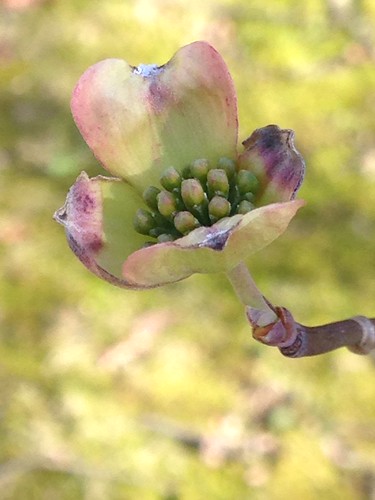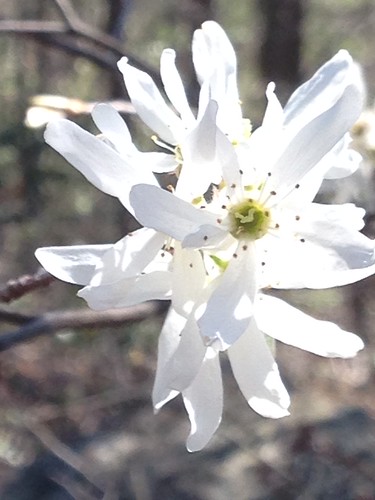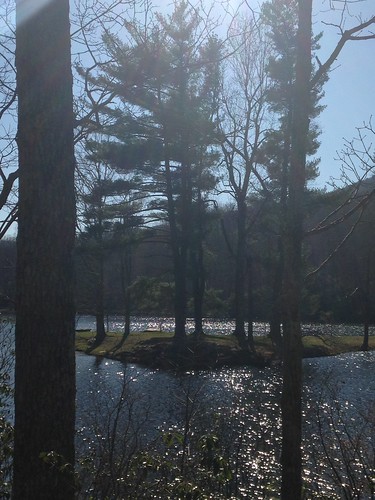
Dogwood flower emerging.
Trying to sneak in a short hike during my granddaughter's nap Sunday, I found myself drawn to the shores of Sherando. Sherando Lake is nestled into a valley beneath the Blue Ridge Mountains near Waynesboro, Virginia. It is a special place. My children were baptized there. We enjoyed many a fine picnic there. Lately, however, the shores of the wonderful old lake have become a more somber place for prayer and quiet reflection. I've gone there in some of the darkest seasons of life to find solace in G-d's Creation.
It must have begun with my old beagle Lucky. As he was nearing the end of his life, he still loved a good trip to the woods. His last hike was on the lake trail and when we got about 100' into the woods, he looked up at me with those big brown eyes that pleaded: "I can't do it anymore." I picked him up and carried him. We savored the smell of an autumn wood together for the last time. The next time I walked that trail, I was alone... but I was NOT alone, as I was pressing close to the Divine in deeply felt prayer.
As I prayed for loved ones and sought refreshment for my spirit, the old trail became a chapel. Many times I felt G-d's tender hand there, yet the trails had become a place of sad memories... so I came in Spring, on the day of Resurrection, full of the joy of Miracles! The serviceberrytrees were in blossom and I saw the first dogwood blossoms. I remembered the fat buds that had been G-d's message to me that there is indeed life to come.
Legend of The Dogwood Tree
Two thousand years ago, few trees in the Middle East were big enough to construct anything. However, one tree was valued above the others for its thick trunk and fine, strong wood. When the Romans came to rule over Jerusalem, their government used this same timber to build the crosses for executing criminals. A group of workers were assigned to gather wood for the crosses. Before long, every Roman official knew the best wood came from these gatherers of execution wood, so those workers became popular.
One day, the wood gatherers received a special request. An officer of the Roman court came and said, "The King of Jews is to be put to death. Deliver an extra-large cross made from your finest wood." So, a fresh tree was cut from the forest of the trees with thick trunks and fine, strong wood. An extra-tall (and extra-heavy) cross was quickly made and delivered.
Three days after the death of Jesus of Nazereth, the chief wood gatherer got alarming news. "All of our finest trees are withering!" the messenger whispered. The wood gatherer hurried to the forest and saw that it was true.
Several years later, the chief wood gatherer heard that, every spring, many people visited the old forest that had once made his job so easy. Despite his advancing years, he set out to discover why. He saw the remains of forest, now like a salty bottoms, with only a few trees still standing tall, bare, lifeless and rotting.
But what was this? As he drew closer, his feeble eyes could make out the people walking among thousands of beautiful, flowering bushes. Seeing one of his own workers there, the old man said, "No one could ever make a cross out of this twisted wood. Our finest tree has gone to the dogs!" He noticed the beautiful white flowers, each blossom looking as if it had been burned from the touch of a miniature cross. -- As told to Ben Baston by his grandmother, Louise Brown. ht/Kristina Elaine Riley
There Is A Legend
At the time of Crucifixion the dogwood had been the size of the oak and other forest trees. So firm and strong was the tree that it was chosen as the timber for the cross. To be used thus for such a cruel purpose greatly distressed the tree, and Jesus nailed upon it, sensed this.
In His gentle pity for all sorrow and suffering Jesus said to the tree: " Because of your regret and pity for My suffering, never again shall the dogwood tree grow large enough to be used as a cross. Henceforth it shall be slender and bent and twisted and its blossoms shall be in the form of a cross--two long and two short petals. And in the center of the outer edge of each petal there will be nail prints, brown with rust and stained with red, and in the center of the flower will be a crown of thorns, and all who see it will remember.
"The pink dogwood is said to be blushing for shame because of the cruel purpose which it served in the Crucifixion. The weeping dogwood further symbolized the sorrow. The red dogwood, called the Cherokee, bears the color to remind us of the blood shed by our Savior.
In my youth, the Legend of the Dogwood was often repeated on postcards in those wonderful old racks you found in roadside diners. We sort of memorized the gist of it but forgot the whole story. Sherando, that wonderful old lake, is a place where I have kneeled often at the feet of the cross... today it shines with the promise of new life!

Serviceberry (Amelanchier arborea) along the side of the lake.




No comments:
Post a Comment